Tooth sensitivity to cold is a dental issue when the tooth’s defensive layer, the enamel or gum tissue, is worn down. Understanding tooth cold sensitivity symptoms, causes, and treatments helps with early detection, effective treatment, prevention, improved quality of life, and oral health maintenance.
Cold sensitivity causes tooth pain, discomfort while eating or drinking cold items, pain with breathing cold air, redness and swelling in the gums, and pus or discharge. Causes include tooth decay, gum disease, cracked teeth, age, plaque buildup, mouthwash use, and acidic foods. Treatments include desensitising toothpaste, fluoride treatments, dental procedures, and maintaining good oral hygiene. Symptoms include persistent pain, sensitivity to hot or cold foods and drinks, and bad mouth taste.
Cold sensitivity is managed through various treatments, including desensitising toothpaste, dental bonding and sealants, fluoride, mouthguards, root canal therapy, and lifestyle changes. Desensitising toothpaste blocks sensory stimuli, dental bonding and sealants protect teeth from sensitivity, fluoride strengthens teeth, mouthguards prevent grinding and clenching, and root canal therapy addresses nerve-related issues. Regular brushing, flossing, and avoiding acidic foods and drinks help reduce sensitivity.
Tooth decay, gum disease, oral products, vigorous brushing, bruxism, and damaged or outdated fillings are causes of tooth sensitivity to colds. Tooth decay exposes the underlying dentin and pulp layers, while gum disease causes inflammation and infection, exposing tooth roots. Oral products, brushing too hard, and grinding increase sensitivity over time.
Teeth sensitivity to cold and impacted teeth are two distinct conditions. Sensitive teeth are sensitive to temperature fluctuations, while impacted teeth cause ongoing discomfort. Sensitive teeth are caused by decay and gum disease, with temporary effects from fillings and crowns. Treatments include desensitising toothpaste, fluoride, dental bonding, mouthguards, root canal therapy, and lifestyle changes. Observation, surgery, eruption aids, and pain relief are also used for impacted teeth. The two require dental intervention, with sensitive teeth requiring desensitising toothpaste and fluoride treatments.
A study by David Clapham and Katharina Zimmermann found that tooth cells called odontoblasts possess cold-sensitive proteins that detect temperature drops. The researchers identified a new function for odontoblasts, known to form dentin. Clove oil, used in dentistry, includes a chemical that blocks the cold sensor protein. The study suggests that nerves sense the direction of movement, signalling tooth sensitivity to cold.
What are the Types of Sensitive to Cold?
The types of cold sensitivity are listed below.
- Generalized Sensitivity: Generalised sensitivity is when several or entire teeth are susceptible to cold triggers that compel sudden pain or discomfort. It is due to enamel wear, gum recession, or underlying dental necessities. Factors such as worn enamel, decreasing gums, tooth decay, cavities, recent dental work, or grinding teeth contribute to the sensitivity. Treatments, including fillings, crowns, or teeth whitening, temporarily expose teeth to cold.
- Localised Sensitivity: Localised sensitivity in teeth refers to a condition where a specific tooth or tooth area is sensitive to cold stimuli. It occurs due to tooth decay, damaged fillings, recent dental work, cracked teeth, or receding gums. Treatment options include desensitising toothpaste, dental bonding, fluoride treatments, and root canal therapy in severe cases.
- Temporary Sensitivity: Temporary sensitivity in teeth refers to a short-term sensitivity to cold stimuli caused by dental procedures such as teeth cleaning, scaling, or therapeutic treatments. The sensitivity resolves as the tooth heals. The other causes include recent dental work, teeth whitening treatments, and professional teeth cleaning, which cause temporary sensitivity due to acidic peroxides.
- Chronic Sensitivity: Chronic sensitivity in teeth refers to persistent sensitivity to cold stimuli over a long period, indicating underlying issues such as enamel erosion, gum disease, or untreated dental decay. Wear on the enamel, decay, gum disease, grinding, damaged fillings, or whitening procedures that irritate teeth due to acidic peroxides are the leading causes of tooth sensitivity.
- Pain with Sweet or Acidic Foods: Cold sensitivity is associated with sensitivity to sweet or acidic foods and beverages, which indicates dental discomfort due to enamel erosion and exposed dentin. It is a symptom of dentin hypersensitivity, where the tooth's outer protective layer wears down, exposing the dentin beneath. Factors contributing to tooth sensitivity include enamel loss, tooth decay, gum infection, and receding gums. Consuming sweet or acidic foods saturates the protective enamel layer and irritates the sensitive areas beneath the enamel.
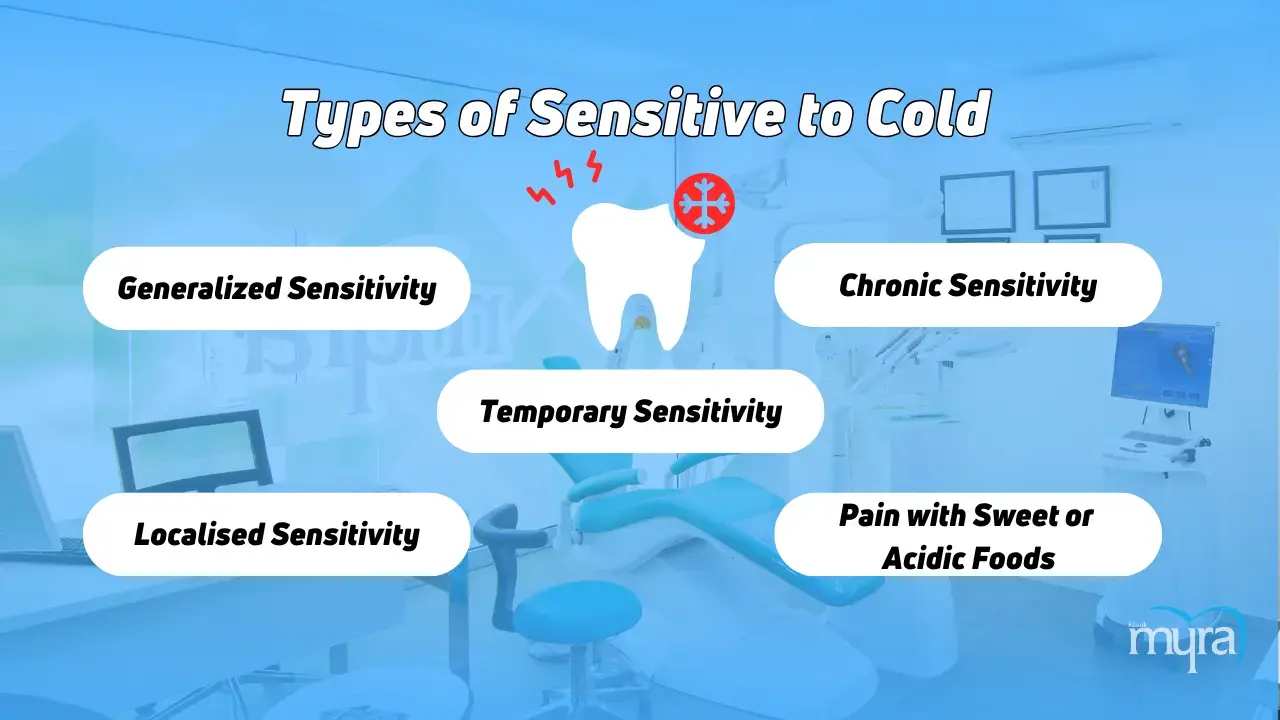
What are the Symptoms of Sensitive to Cold?
The symptoms of sensitivity to cold are listed below.
- Intense tooth pain: Intense tooth pain due to cold sensitivity is a standard discomfort that impacts daily activities. Sharp, sudden pain that lasts for a few seconds or longer and causes persistent sensitivity distinguishes intense tooth pain. The causes include worn or thinning enamel, tooth decay, gum disease, cracked teeth, grinding, teeth whitening treatments, age, plaque buildup, mouthwash use, and acidic foods.
- Discomfort while eating or drinking cold items: Discomfort while eating or drinking cold items is a symptom of dental sensitivity to cold, causing sudden, intense pain that subsides once the cold item is removed from contact with the teeth. Cold temperatures stimulate nerves within the tooth, causing discomfort when they expose the dentin, the layer beneath the tooth enamel. Treatments include desensitizing toothpaste, fluoride treatments, or dental procedures. Maintaining good oral hygiene and avoiding acidic foods and drinks help prevent prolonged sensitivity.
- Pain with breathing cold air: Breathing in cold air causes pain or discomfort, a symptom of cold-induced sensitivity, which affects the teeth and the respiratory system. Teeth sensitivity causes sharp, sudden pain when the dentin, the layer beneath tooth enamel, is exposed. Respiratory sensitivity occurs due to the irritation and dryness of the airways. Pain with cold air manifests as a sharp, sudden sensation localized to distinct teeth or areas of the mouth. The pain naturally lasts as long as the cold air is in contact with the sensitive teeth, and it subsides quickly once the air warms up or is no longer inhaled.
- Redness and swelling in the gums: Redness and swelling in the gums are signs of gum disease, such as gingivitis or periodontitis, caused by the buildup of plaque around teeth, which leads to inflammation and infection. Causes include poor oral hygiene, gingivitis and periodontitis, vitamin deficiencies, hormonal changes, medication side effects, and smoking. Treatment depends on the cause, wherein if gum disease is the cause, a dentist or periodontist recommends treatments such as antibiotics, brushing and flossing, tooth scaling, root planing, or surgery.
- Pus or discharge: Pus or discharge from the gums indicates an underlying condition, such as a gum abscess. A gum abscess is a pocket of pus formed due to an infection in the space between teeth and gums, caused by bacteria from poor oral hygiene, periodontal disease, or food and plaque. The presence of pus causes gums to become inflamed and recede, exposing the sensitive dentin layer of teeth and leading to sensitivity to cold. Symptoms include persistent, severe pain, sensitivity to heat or cold foods and drinks, pain while chewing, loose teeth, bad taste in the mouth, and fever.
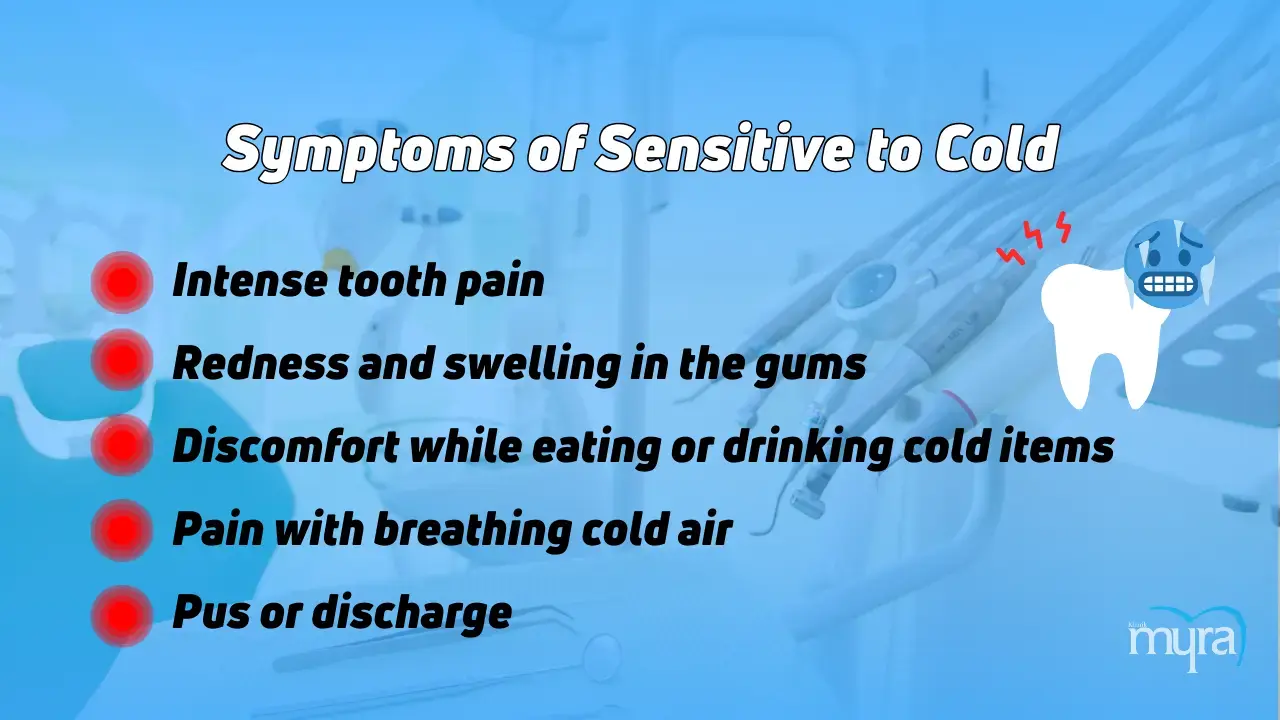
What are the Causes Sensitive to Cold?
The causes of sensitivity to cold are listed below.
Tooth decay or gum disease: Tooth decay, or cavities, generates sensitivity to cold due to the erosion of tooth enamel, uncovering the underlying dentin and pulp layers. The layers contain tiny tubules that lead to nerve endings in the tooth, causing sharp pain or discomfort. Gum disease is an infection of gum tissue and bone that causes the gums to recede, exposing the roots of the teeth. The roots do not have a protective enamel layer, making them vulnerable to cold temperatures. Gum disease causes inflammation and infection of the gums and supporting structures, exacerbating tooth sensitivity. Losing support structures increases tooth mobility and exposes teeth to sensitive root surfaces.
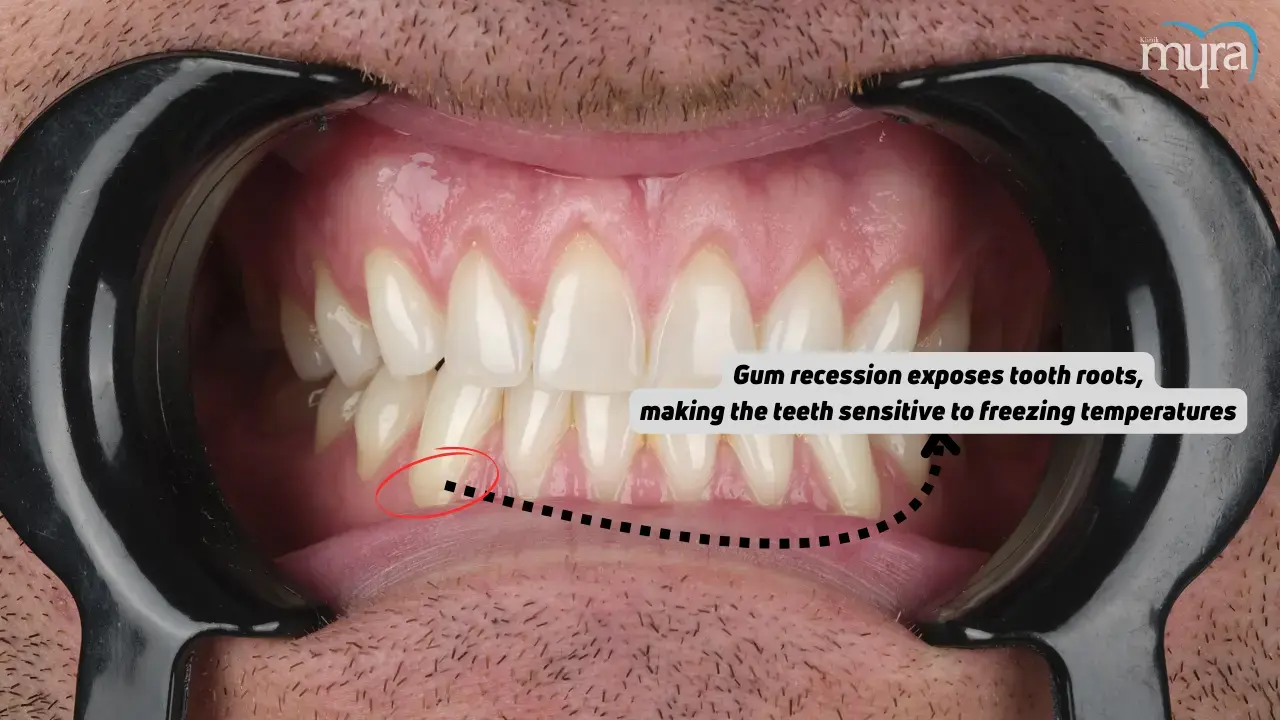
Effects of oral products: Oral products deepen teeth's sensitivity to cold. Teeth whitening products, hardening solutions, and whitening creams wear down the enamel layer, exposing the dentin and causing sensitivity. Mouthwashes worsen teeth' sensitivity by exposing dentin, exposing sensitive teeth underneath, and irritating nerves. High-abrasive toothpastes wear down enamel. Alcohol-based mouthwashes dry out the mouth.
Brushing too hard: Strong brushing causes tooth sensitivity to cold. The enamel, the protective outer layer of teeth, wears down, exposing the underlying dentin, which contains microscopic tubules that connect to nerve endings inside the tooth. Toothbrush abrasion increases the surface area exposed to cold stimuli. The effects of brushing too hard are cumulative, with more enamel worn down and gums receding, leading to increased sensitivity over time.
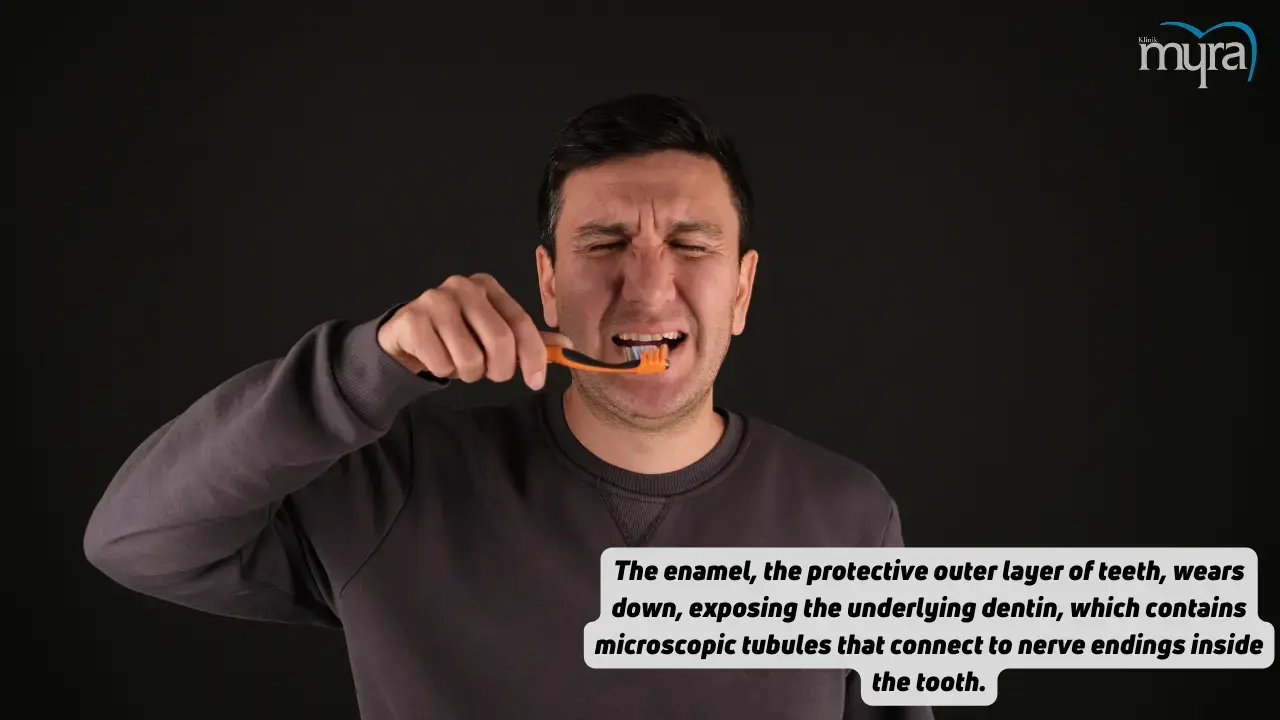
Bruxism: Bruxism, or teeth grinding, causes sensitivity to cold due to enamel erosion, dentin exposure, gum recession, and jaw disorders. Thin enamel exposes nerve endings, causing sensitivity to cold temperatures. Excessive grinding leads to worn-down teeth, exposing the dentin layer. Gum recession exposes tooth roots, making the teeth sensitive to freezing temperatures. Jaw disorders and headaches worsen discomfort due to bruxism.
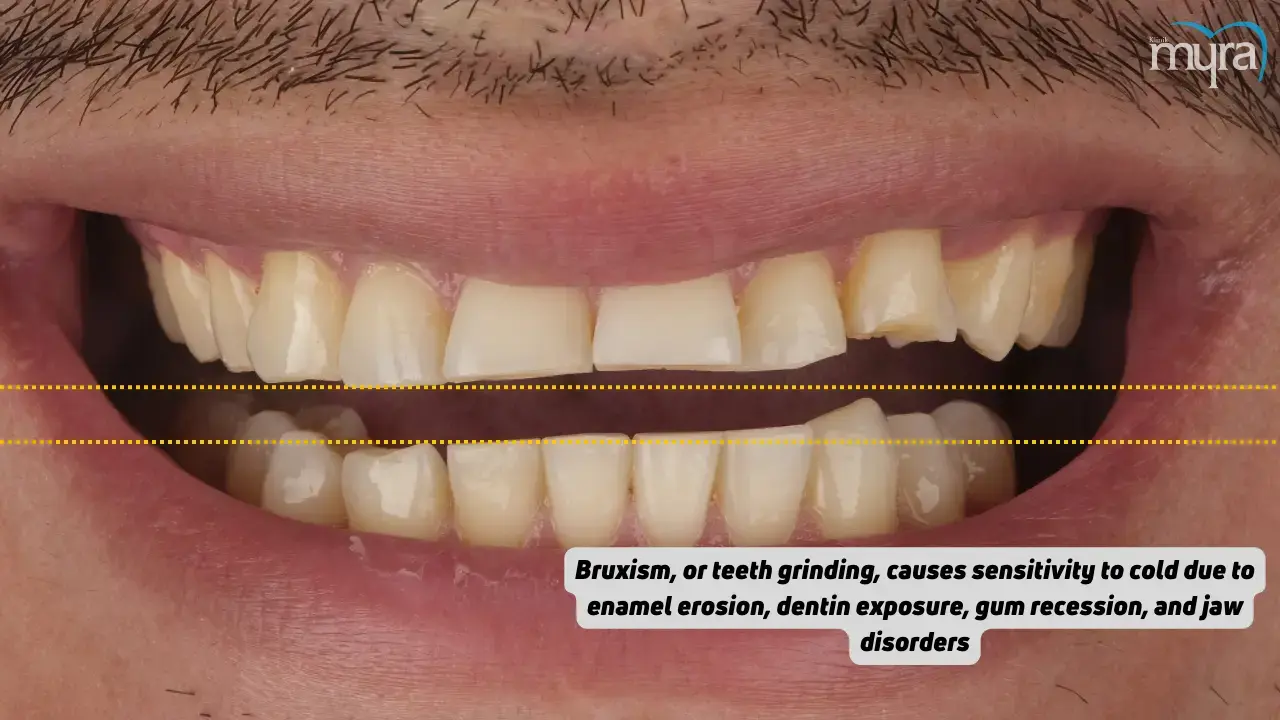
Damaged or old fillings: Dental fillings treat cavities and restore missing tooth's function, integrity, and morphology. It provides a protective barrier, protecting sensitive tooth parts from exposure to temperature changes and chemicals. Fillings deteriorate or sustain damage over time due to constant pressure from chewing, grinding, clenching, accidents, or trauma. Contact with hot, cold, sweet, or acidic foods or drinks stimulates nerves and cells inside the tooth, leading to tooth sensitivity.
What are the Treatments of Sensitive to Cold?
The treatments for cold sensitivity are listed below.
Dental bonding or sealants: Dental bonding and sealants are two dental treatments that protect teeth from sensitivity. Bonding involves applying a tooth-colored resin material to the tooth and hardening it with light, reducing sensitivity. Sealants seal over the grooves on the back teeth's chewing surfaces, preventing tooth decay by protecting them from acid.
Fluoride: Fluoride is a natural mineral that strengthens teeth and prevents cavities by remineralizing areas lost to calcium and phosphate minerals. It protects against bacteria by inhibiting their metabolic enzymes, reducing the ability to produce cavity-causing acids. Dentists offer professional fluoride treatments, which are highly concentrated and take a few minutes to apply, requiring 30 minutes of absorption.
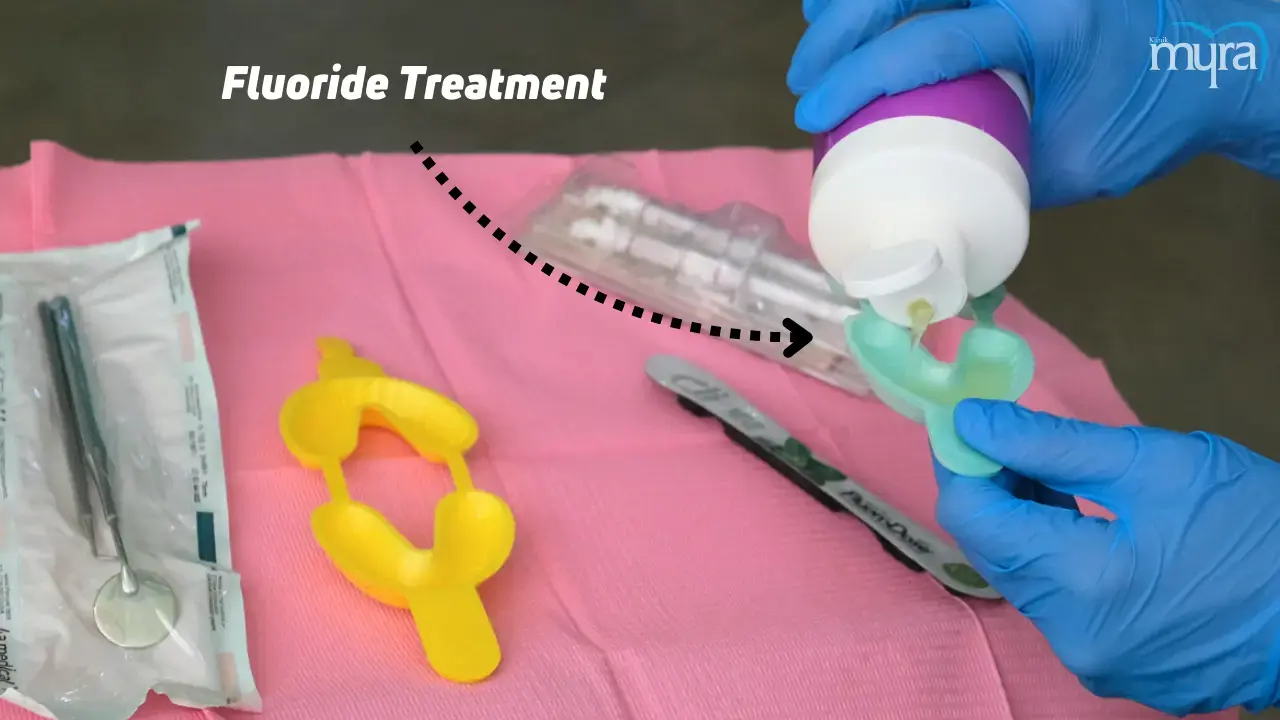
Mouthguard: A mouthguard is a custom-made oral device worn over teeth during sleep to prevent grinding and clenching, a condition that wears away tooth enamel and exposes dentin, causing sensitivity. Mouthguards are custom-made to fit the person's dental anatomy and to be more comfortable than store-bought ones. They provide protection during sleep by causing the jaw to loosen up to prevent grinding. They indirectly help manage sensitivity to cold in teeth in cases where grinding contributes to or worsens the issue.
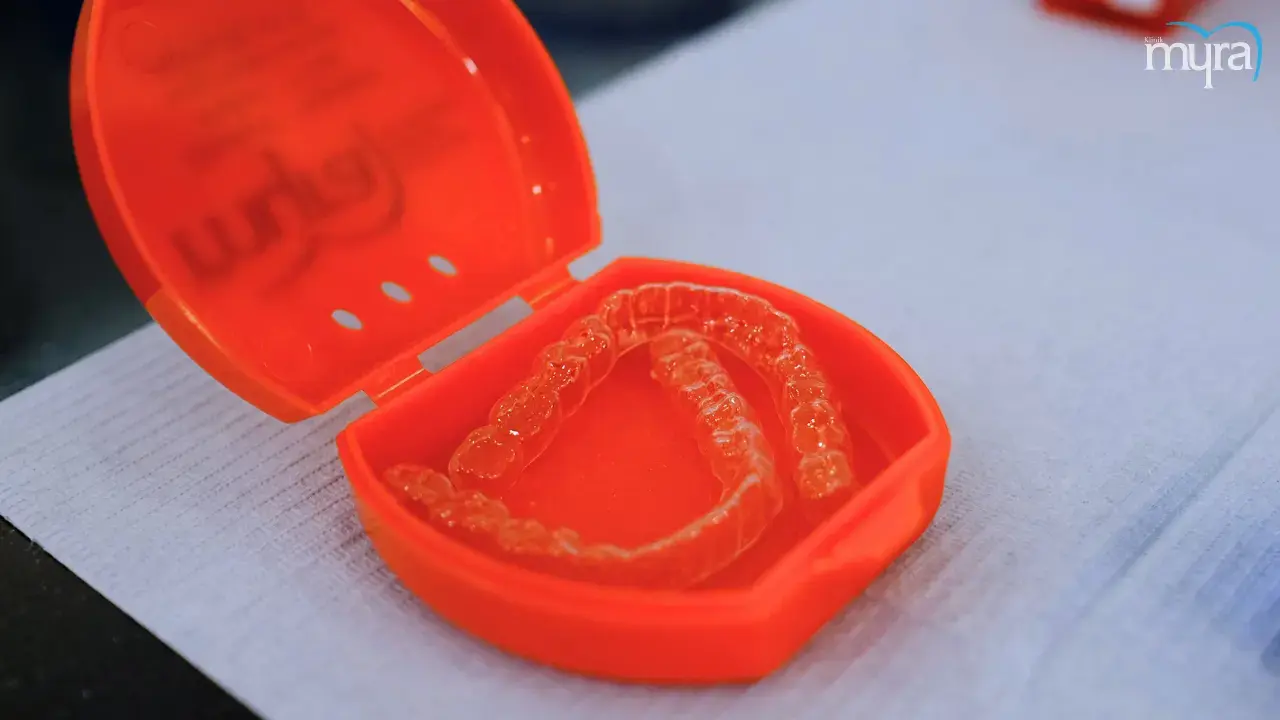
Root canal therapy: Root canal therapy is a treatment that addresses tooth sensitivity to cold due to nerve-related issues. It involves anesthesia, drilling through the tooth to access the pulp chamber, removing unhealthy nerve tissue, cleaning and shaping root canals, filling and sealing with biocompatible material, and restoration with a crown. The tooth becomes insensate, meaning it no longer feels temperature changes, preventing further damage.
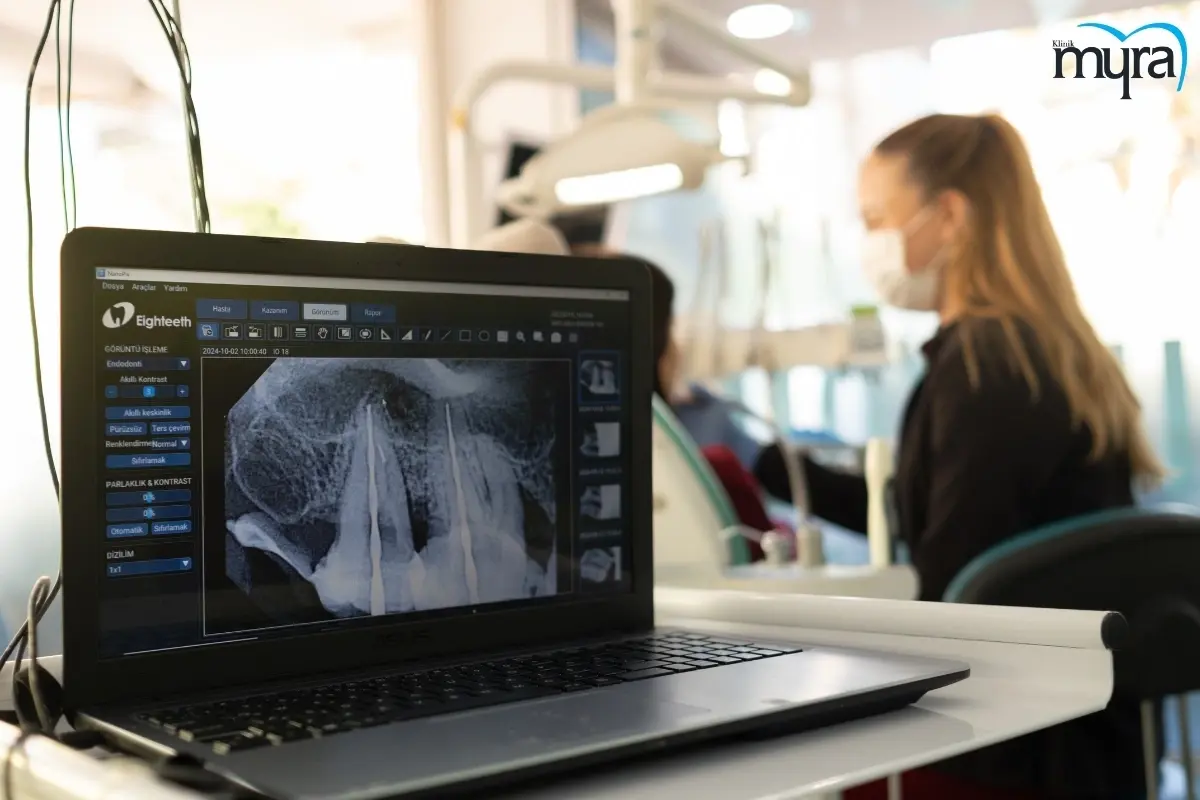
Desensitizing toothpaste: Desensitizing toothpaste reduces tooth sensitivity by blocking sensory stimuli from tooth enamel to nerve roots in dentin tissue. Active ingredients such as potassium nitrate or strontium chloride block pain signals and protect dentin from exposure to air and food. Desensitizing toothpaste requires repeated applications for relief, and temporary relief is experienced after using it regularly. Desensitizing products contribute to the development of gingival aesthetics, which is the healthy appearance of the gums.
Lifestyle changes: People with sensitive teeth must use a soft-bristled toothbrush, avoid acidic foods and drinks, avoid sudden temperature changes, stop smoking and drinking alcohol in moderation, and stop grinding or clenching their teeth. Regular brushing and flossing, using a soft-bristled toothbrush, avoiding acidic foods and drinks, and reducing stress levels help protect tooth enamel and reduce sensitivity.

Can Sensitive to Cold Be Treated At Home?
Yes, cold sensitivity can be treated at home. The sensitivity is effectively managed at home through various methods to improve dental health and reduce sensitivity. Home remedies for pain relief include desensitizing toothpaste, brushing correctly, avoiding acidic foods, and maintaining good oral hygiene. Other recommended home remedies include mouth guards, oil pulling, salt water rinse, clove oil, hydrogen peroxide rinse, honey, turmeric, green tea, capsaicin, and vanilla extract.
Desensitizing toothpaste contains compounds that block pain signals from nerve endings to the brain. A soft-bristled toothbrush and a low-acid or fluoride mouth rinse are recommended. Saltwater rinse is an effective antiseptic and reduces inflammation. Gargle with a saltwater rinse twice daily to alleviate pain symptoms from sensitive teeth. Hydrogen peroxide is a mild antiseptic and disinfectant used to sterilize cuts, burns, and other wounds to prevent infection. It is used as a mouth rinse to heal gums and avoid inflammation. Honey and warm water are antibacterial agents that promote oral healing and reduce pain, swelling, and inflammation.
Turmeric, a natural anti-inflammatory agent, is massaged on teeth or made into a paste for pain relief. Green tea has antioxidant and anti-inflammatory properties and is used as a mouthwash twice daily. Capsaicin, found in chili peppers, has analgesic properties and treats burning mouth syndrome. Vanilla extract is used to treat baby teething pain. Maintaining good oral hygiene, using a softer brush, limiting acidic foods, scheduling regular dental visits, and using a mouthguard at night help prevent further damage. Home remedies for oral pain and tooth sensitivity temporarily alleviate discomfort but not cure the root cause. Treatment from a dentist is recommended to discuss further options and long-term solutions.
What are the Researches about Sensitive to Cold?
The research about cold sensitivity includes odontoblasts and cold sensitivity. A study published in Science Advances on March 26, 2021, found that tooth cells called odontoblasts contain cold-sensitive proteins that detect temperature drops. David Clapham and Katharina Zimmermann led the study, and it identified a new function for odontoblasts, known to form dentin, the shell beneath the tooth’s enamel. The study explains how one age-old home remedy eases toothaches. The central ingredient in clove oil, used for centuries in dentistry, contains a chemical that blocks the cold sensor protein. Developing drugs that target the sensor eliminates tooth sensitivity to cold.
Teeth decay occurs when films of bacteria and acid eat away at the enamel. The researcher’s theory explains that tiny canals inside the teeth contain fluid that moves when the temperature changes. Researchers have suggested that nerves sense the direction of movement, which signals whether a tooth is hot or cold. The team focused on ion channels, pores in cells' membranes that act like molecular gates.
What is the Differences between Sensitive to Cold Teeth and Impacted Teeth?
The difference between sensitive to cold and impacted teeth is that sensitive to cold are teeth sensitive to temperature fluctuations, while impacted teeth occur when a tooth fails to erupt fully. Teeth sensitivity to cold is caused by thinning enamel, tooth decay, damaged fillings, recent dental work, gum disease, and tooth grinding. Teeth sensitivity has a temporary effect due to procedures such as fillings, crowns, or teeth whitening treatments.
Impacted teeth occur when a tooth fails to break through the gum line and properly align within the dental arch. Impacted teeth are caused by crooked or twisted teeth, insufficient jawbone space, or overcrowding, which prevents normal tooth eruption due to small jaws or extra teeth. Teeth sensitivity to cold and impacted teeth are treated using desensitizing toothpaste, fluoride treatment, dental bonding or sealants, mouthguards, root canal therapy, and lifestyle changes. Observation, surgery, eruption aids, and pain relief treat impacted teeth.
Fluoride treatment, dental bonding, mouthguards, root canal therapy, lifestyle changes, regular check-ups, and consultation with a dentist are needed to treat tooth enamel sensitivity. Lifestyle changes such as using soft-bristled toothbrushes, avoiding abrasive toothpaste, and avoiding acidic foods help reduce sensitivity. Treatments for impacted teeth include observation, surgery, eruption aids, and pain relief. Observation helps prevent complications from the tooth not fully erupting. Extraction surgery is recommended for impacted wisdom teeth, while eruption aids help canines erupt naturally. Painkillers and warm saltwater rinses ease the discomfort an impacted tooth brings.
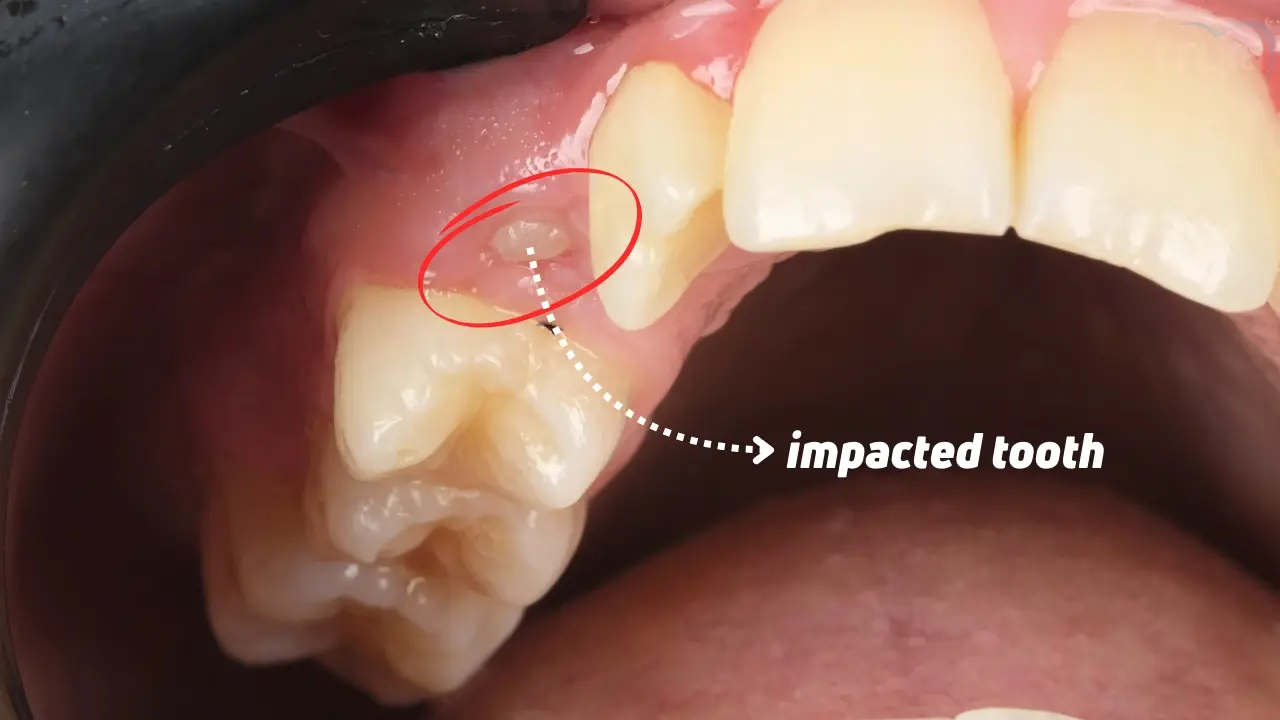
Sensitive and impacted teeth are conditions that cause discomfort and affect oral health. Sensitive teeth cause temporary pain when exposed to cold temperatures, while impacted teeth cause ongoing discomfort. The two conditions require dental intervention, with sensitive teeth requiring desensitizing toothpaste, fluoride treatments, or dental procedures. Preventive care, such as regular brushing and flossing, helps maintain healthy enamel and prevent sensitivity.





